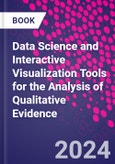The real barrier is the hundreds of R code lines required to apply these concepts to their databases. By removing the coding proficiency hurdle, this book will empower their research endeavors and help them become active members of and contributors to the applied data science community. The book offers a comprehensive explanation of data science and machine learning methodologies, along with access to software application tools to implement these techniques without any coding proficiency. The book addresses the need for innovative tools that enable researchers to tap into the insights that come out of cutting-edge data science tools with absolutely no computer language literacy requirements.
Table of Contents
Part I. Introduction to Data Science and Interactive Visualization Tools for the Analysis of Qualitative Evidence1. Truly Equal-Status Mixed Methods Design (TESM2D)
2. Textual and Relational data (TRD)
3. Digital Ethnography, Data Science, and Ethical Considerations
4. Bool Plan and Organization
Part II. Network modeling frameworks
5. Network Analysis of Qualitative Data (NAQD)
6. Graphical Retrieval and Analysis of Temporal Information Systems (GRATIS)
7. Visual Evolution, Replay, and Integration of Temporal Analytic Systems (VERITAS)
8. Relational Frameworks for Data Mining and Data Retrieval via Co-authorship Networks (CN)
Part III. Machine Driven Text Classification and Statistical Modeling frameworks
9. Latent Code Identification (LACOID)
10. Machine Driven Classification of Open-ended Responses (MDCOR)
11. Machine Driven Literature Classification (MDLC)
Part IV. Integration of Network and Text Classification Analyses
12. In what instances should or could we integrate the analyses and frameworks described in parts I and II?
13. Incorporating Spatial Context for Data StoryTelling: GeoStoryTelling
14. Sentiment Network Modeling
15. Closing thoughts and future work








